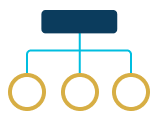
Advocate
Utilize technology to increase self-sufficiency and promote independence.
People with disabilities will live, play, and work increasingly individualized and independent lives in mainstream communities. The question is how supportive services will be enhanced, changed, adapted, or even minimized based on individual needs and goals to achieve this independence.
The answer is technology. Today’s world is filled with many new and exciting technologies—many geared towards making life simpler and easier. These same technologies are being utilized to help increase independence and assist in daily tasks for people living with disabilities.
Safety and Security
Technology is only as good as the plan in place. Individuals, families, providers, and case managers collaborate to create a solution that provides the right level of support. The team will collectively decide which options work best for their situation and comfort level. Technology supports are not all or nothing. Solutions range from medication reminders to remote supervision systems. Many options can be implemented in phases over time to ensure the system put in place works as expected and the desired results are achieved.
Independence
Many simple options exist that can help with daily tasks. Low-cost phone applications are able to help with reminders, and personal home assistants (such as Amazon Echo and Google Home) can help program lights, music, and more. From these consumer-based technologies to remote support system integration, technology has amazing potential to increase independence.
With so many options available, it can be a little overwhelming. The Technology Resource Center provides the information needed to make an informed decision.
Begin the process to:
- Find the technology option that’s right for those living with disabilities
- Learn about safety and security
- Discover available options








